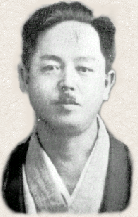SHITO RYU KARATE-DO
 Shito-Ryu Karate-Do is one of the main karate styles today. It was founded by Kenwa Mabuni (born 14th November 1889 in Shuri on the island Okinawa), the 17th descendant of the prince Onigusuki, a legendary war lord of the Ryukyu kingdom (old Name of Okinawa).
Shito-Ryu Karate-Do is one of the main karate styles today. It was founded by Kenwa Mabuni (born 14th November 1889 in Shuri on the island Okinawa), the 17th descendant of the prince Onigusuki, a legendary war lord of the Ryukyu kingdom (old Name of Okinawa).
Kenwa Mabuni started the study of Shuri-te, also known as Shorin-Ryu, with the famous Master Yasutsune (Anko) Itosu (1830-1915) of Shuri, a student of Master Sokon Matsumura (1792-1887), with the age of 13. Another famous student of the Itosu school was Gichin Funakoshi (1886-1957), the founder of Shotokan Karate-Do. At the age of 20, Kenwa Mabuni started with the study of Naha-te, also known as Shorei-Ryu, with the other great famous martial artist of this time, Master Kanryu Higashionna (Higaonna) (1853-1915), to whom he was introduced by his close friend Chojun Miyagi (1888-1953), the later founder of Goju-Ryu.
After finishing his education and military service, Kenwa Mabuni joined the okinawan police force. This occupation allowed him to visit the different regions of Okinawa and learn many of the classical martial arts of the island, known as
Ryukyu-Kobudo. For a longer time, he was a student of Master Seisho (Kamadeunchu) Aragaki (1840-1918), who taught a similar style to the Naha-te of Master Kanryu Higashionna. From master Aragaki he learned several karate and and Sai-Jutsu by Master Tawada.
In the 20 of this century he taught together with Chojun Miyagi (Naha-te), Choyu Motobu (Shuri-te and Gotende, the combat system of the old okinawan royal house), Chomo Hanashiro (Shuri-te) and Juhatsu Kiyoda (Naha-te) in the famous Ryukyu Tode Kenkyu-Kai (Okinawan Karate Research Club). Here, he learned some Fukien 'White Crane Fist' and Pangai Noon (hard and soft) forms from the chinese trader Master Wu Xian Gui (Go Kenki).
After Master Gichin Funakoshi introduced karate to Japan in 1922, Kenwa Mabuni gave several exhibitions of his art on the japanese main islands. Most of this time he stayed in Osaka, where he taught karate do in several dojo. In 1929, he finally moved to Osaka and opened his own dojo to teach his version of karate do.
Master Mabuni founded his method on the teachings of his 2 main teachers, Master Yasutsune (Anko) Itosu from Shuri and Master Kanryu Higashionna from Naha. In the name he choose for his new art, Shito-Ryu, he used the initials of these great Masers: "Shi" which is a variation in the pronunciation of "Ito" in Itosu, and "To" is a variation in the pronunciation of "Higashi" in Higashionna (Higaonna).
By combining the two styles of Shuri-te and Naha-te together and through systematize their approaches he created the basis of what Shito-Ryu is today: A style based on a systematic training methods, combining the concepts of Shuri-Ryu and Shorei-Ryu to a logical unit.
The symbol of Shito-Ryu is the family coat of arms of the house Mabuni
 This Symbol of Shito-Ryu was the coat of arms of the house Mabuni for many centuries. The circle is a symbol for peace and harmony (Wa). The vertical and horizontal lines represent the calligraphy for "human being" or "human beings". Thus, the symbol signifies "human beings working in peace and harmony".
This Symbol of Shito-Ryu was the coat of arms of the house Mabuni for many centuries. The circle is a symbol for peace and harmony (Wa). The vertical and horizontal lines represent the calligraphy for "human being" or "human beings". Thus, the symbol signifies "human beings working in peace and harmony".
After the move to Osaka (1927-28) Soke Kenwa Mabuni started to teach Shito-Ryu Karate Do full time as his main profession.
During the next years Soke Mabuni tried to develop his Shito-Ryu Karate-Do and to spread it the region of Osaka. To proof the effectiveness of his martial art, he gave many demonstrations and taught free self defense classes in police stations all over western Japan.
Due to his success in 1931 the DAI NIHON KARATEDO KAI was founded. This group was the predecessor of the "World Shito-Kai Karatedo Federation". Shito-Ryu Karate-Do was now widely accepted and Soke Mabuni started to teach many students at his home and at different universities. Amongst his many students were his 2 sons, Kenei Mabuni and Kenzo Mabuni, Chojiro Tani (the founder of Tani-ha SHUKOKAI), Ryusho Sakagami (the founder of Shito-Ryu Itosukai), Yoshiaki Tsujikawa, Ken Sakio, Jun-ichi Inoue, Manzo Iwata, Toshiyuki Imanishi, Kazuo Kokuba, Tokio Hisatomi and Ryusei Tomoyori.
Kenwa Mabuni, Sensei died on March 23rd 1952 aged 64. His oldest son, Kenei Mabuni, became his heir and successor as head of Shito-Ryu. He heads the central school of Shito-Ryu, the Yoshu-Kan in Osaka, and also the Union Shito-Ryu Europe, since its foundation in 1990.
|
|
|
|
|
|
|
|
|
|
|
|
|
|
